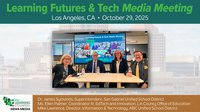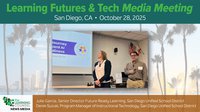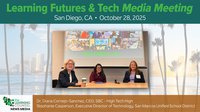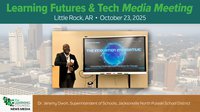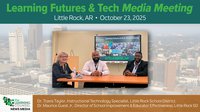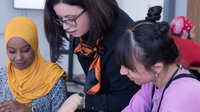When Sheena Vaidyanathan teaches computer science to middle school students, she draws upon her experience as an art teacher.
Vaidyanathan has her students learn the basics of coding by creating clever art and animations—works that would be nearly impossible to create with a pencil and paper but can be done with just a few lines of code.
“These are simple things that have universal appeal,” she says.
Once students are familiar with basic coding concepts, Vaidyanathan—who teaches at Los Altos School District in the heart of Silicon Valley—sets them loose to develop their own projects about something they really care about.
Tapping into students’ creativity is one of the keys to engaging more girls in what continues to be a male-dominated discipline. According to the National Center for Women and Information Technology, young women make up 56 percent of Advanced Placement test takers but only 19 percent of those who take the AP Computer Science exam—and just 18 percent of undergraduate computer science degrees are earned by women.
Corinne Roller, director of advocacy and public policy for the nonprofit group Girls Who Code, says the proportion of women in computing jobs has actually been trending downward over the last few decades.
“If you look at the original Mac development team from the 1980s, it’s half women,” she observes. “Now, we’re down to just 24 percent of coding and computing jobs held by women.”
The lack of participation among women in this important field has serious consequences not only for women’s economic empowerment but for the future of technological innovation, Roller says.
“Computing jobs are growing at three times the national average. Every single company in every single industry has a demand for computing jobs. It’s really important that we give all students the skills to get these jobs, because they pay two or three times the national average,” she says.
“But that’s only one reason why schools should be focused on closing the gender gap. Not only are we leaving girls behind, but we’re also leaving behind the innovations they might create. We’re leaving behind their perspectives. We need to be creating technology from a much larger and more diverse perspective.”
Have students solve the world’s problems
One problem is the way computer science is taught in many schools. As Vaidyanathan notes, educators must emphasize the creative nature of the field.
“The traditional way computer science has been taught has been very math-focused, using computers to solve math problems,” says Hadi Partovi, founder of Code.org, which offers a free coding curriculum for students. “That doesn’t excite people much. The way to make it much more broadly appealing is as a creative field to help solve the world’s problems. When you talk about solving the world’s problems, that engages a lot more students.”
And it’s an approach that seems to resonate with girls in particular.
Girls Who Code provides free resources to help schools establish after-school coding clubs for girls. All a school needs to start a club is an adult facilitator, and Girls Who Code provides the curriculum and other resources, including an online portal where coding projects can be stored and accessed.
“Computer science is not about fingers to keys. It’s really about solving problems,” Roller says. “In all of our programs, we’re working with the girls to build toward a final project. The project is always to solve a problem they see in their community, whether that’s their neighborhood, their school, or the wider world. These projects are all designed to improve people’s lives.”
She adds: “Having an impact on your community is something that really draws girls in. We believe girls are change makers. We want to teach them to code so they can change the world.”
Counteract stereotypes
The way computer science is taught isn’t the only barrier to engaging more girls in the subject. Closing the gender gap also requires changing cultural perceptions about who coders are and what they look like.
“When you ask people to name a famous coder, you hear names like Bill Gates and Mark Zuckerberg,” Roller says. “The names you hear are primarily men. You can’t be what you can’t see. For girls in particular, having a lack of female role models in technology careers has been shown to have an adverse effect on their interest level and persistence in computer science.”
Educators must show students that coding is a field that includes women and minorities as well. To help meet this need, Girls Who Code has created free curriculum materials built around female role models, called Women in Tech.
“It’s a series of lesson plans for middle school students that teach computational thinking concepts through the lens of diverse women who are making critical advances in this industry,” Roller says.
Educators and administrators should pay attention to the language and images they use to promote computer science opportunities, to make sure these are gender-inclusive. Guidance counselors should be trained to avoid implicit bias in recommending courses for students: “We hear anecdotally from girls all the time that they really wanted to take coding, but they were steered away,” Roller says. And teachers need training on how to make their classrooms feel inclusive for all learners.
“It’s not enough just to teach coding,” Roller says. “You have to teach it in a way that makes girls feel included, and that makes them feel like they’re in a space where they can take risks. So much success in coding is about iteration, getting things wrong the first time but then making changes. For girls, that can be a really hard concept to embrace.”
Get them coding early on
Another strategy that has proven to be effective in engaging more girls in computer science is to introduce the topic at an early age.
“Research shows that if girls are involved in computer science in middle school, they are much more likely to persist in pursuing computer science through high school and into college and a career,” Roller says. “If girls aren’t taking computer science before the end of eighth grade, they are highly unlikely to take it in high school. By then, a lot of the cultural stereotypes around who a coder is have calcified for them.”
New Hampshire has been successful in engaging many girls in coding as early as the fifth grade through a statewide coding challenge. Organized by the New Hampshire-based company Intelitek, whose online CoderZ platform gives students an accessible way to learn coding skills, the competition has students write code to control 3D simulations of robots as they aim to solve various problems.
The Cyber Robotics Coding Competition began in New Hampshire in fall 2017, with 2,600 students taking part across the state. This school year, it has grown to encompass 37,000 students in 26 states—and another 30,000 students in Vietnam.
In New Hampshire’s second year of competing, more than 4,200 students from 61 schools completed nearly 30,000 missions in the weeks leading up to the finals. At least a third of the competitors were girls.
“We think it’s important to engage all of our students in coding and computer science, with the goal of helping the achieve bright futures,” says New Hampshire Commissioner of Education Frank Edelblut. “Introducing students to coding early on in their education helps accomplish this goal.”
Engage without intimidation
In many schools, coding and computer science education are introduced through after-school robotics programs, says Ido Yerushalmi, CEO of Intelitek. Not only is the cost of these programs high, but they tend to have a “boys club” feel to them, because girls are often outnumbered by boys. “For this reason, many girls simply don’t get involved,” he says.
Using a platform such as CoderZ, students can learn the principles of coding and engineering individually or in small teams, making the experience less daunting for them. What’s more, introducing the program to girls (and boys) who have no natural inclination toward computer science as part of the general curriculum could change their minds about a career in computer science, or at least open the door to new possibilities.
“This approach can expand girls’ participation in coding and engineering programs by giving them the start they need,” Yerushalmi says.
Dennis Pierce is a freelance writer with more than 20 years of experience reporting on education. He can be reached at denniswpierce@gmail.com.




